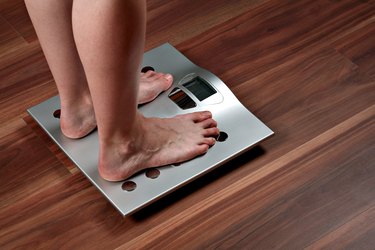
When you weigh yourself, the scale cannot differentiate between muscle, fat, water, bone or internal organs. In fact, a scale doesn't know if you are human being or a bag of rice. If you have recent weight gain, it's important to know if it's muscle or fat. Look for several signs to recognize fat or muscle gain; there are also tests that can be done to give you an accurate measurement.
Exercise
Video of the Day
If you consistently perform resistance exercises and see a small, slow weight gain, chances are you are putting on muscle. Muscle is important because it increases your metabolism, gives your body shape and firmness and keeps you strong. According to ExRx, a pound of muscle can burn up to 50 calories in a day, which is why muscle improves your metabolism and is so important to your health and wellness. If you gain weight but do not exercise regularly, it is most likely an increase in your body fat percentage.
Video of the Day
Clothing
If you have put on a small amount of weight but your clothes are getting looser, this is a tell tale sign that you are gaining muscle. Muscle is dense, firm and takes up less room than fat. On the other hand, fat is voluminous and takes up more space, which results in clothes that are tighter. Also, a rapid or significant weight gain is an indicator of an increase in body fat.
Body Composition Testing
Most gyms offer their members free body composition testing done by a fitness professional. Skin fold measurements are taken on specific areas of your body and are used in a mathematical formula along with your age and gender. If you gain weight that is muscle, your body fat percentage will go down; if your weight gain is fat, your body fat percentage will go up. If possible, have this test done once a month and preferably by the same person for accuracy.
Hydrostatic Weighing
The American Council on Exercise says that hydrostatic weighing is the gold standard for body composition testing and is considered the most accurate way to find out what your body fat percentage is. The lab determines your body fat by seeing how buoyant or heavy you are in water. You're weighed on dry land first and then submerged in a tank of water. After blowing all the air out of your lungs, hold your breath for one minute while the lab weighs you while you're submerged.